It’s finally happened — you’ve started a new business, and your customer base is starting to expand. But even though you’re making progress, you still feel like you could be doing better.
There’s a whole world of untapped potential around you — prospects that you know would benefit from your product or service. And the issues you’re running into are less about your solution’s soundness and more about how you can reach your potential base.
That’s where business proposals come in — they can bridge the gap between you and potential clients. A solid one can outline your value proposition and persuade a company or organization to do business with you.
Here, we’ll take a look at the various kinds of business proposals, go over how to write one, see some ideas and examples to help guide yours.
Know exactly what you need? Jump to one of the following sections:
- Types of Business Proposals
- How to Write a Business Proposal
- Business Proposal Ideas
- Business Proposal Examples
What Is a Business Proposal?
A business proposal is a formal document that is created by a company and provided to a prospect with the purpose of securing a business agreement.
It’s a common misconception that business proposals and business plans are the same. The proposal’s aim is to sell your product or service, rather than your business itself. Instead of assisting your search for investors to fund your business, a proposal helps you seek new customers.
Types of Business Proposals
There are two types of business proposals: unsolicited and solicited.
- Unsolicited Business Proposals – With unsolicited business proposals, you approach a potential customer with a proposal, even if they don’t request one, to gain their business.
- Solicited Business Proposals – Solicited business proposals are requested by a prospective client.
In a solicited business proposal, the other organization asks for a proposal with an RFP (request for proposal). When a company needs a problem solved, they invite other businesses to submit a proposal which details how they’d solve it.
Whether the proposal is solicited or unsolicited, the steps to create your proposal are similar. Ensure it includes three main points: a statement of the problem the organization is facing, proposed solution, and pricing information.
Before writing your business proposal, it’s crucial you understand the business you’re writing the proposal for. If they’ve sent you an RFP, make sure you read it carefully so you know exactly what they’re looking for. It can also be helpful to have an initial call or meeting with the new client to ensure you fully understand the problem they’re trying to solve and their objectives.
Once you’ve done your research, it’s time to begin writing your business proposal. There’s no one-size-fits-all approach to writing a business proposal, but let’s take a look at some elements proposals often include. (I designed this example business proposal using Canva.)
Follow Along With HubSpot’s Business Proposal Template

Download the Template for Free
1. Begin with a title page.
You have to convey some basic information here. Introduce yourself and your business. Be sure to include your name, your company’s name, the date you submitted the proposal, and the name of the client or individual you’re submitting the proposal to.
Your title page should reconcile engagement with professionalism. It’s a tone setter, so you need to make sure yours is sleek, aesthetically appealing, and not too “out there.”
Here’s an example of what it looks like when done right:

2. Create a table of contents.
A solid UX is valuable in virtually any context — and business proposals are no exception. You need to make things as simple and accessible as possible for the people on the other side of your proposal. That starts with a table of contents.
A table of contents will let your potential client know exactly what will be covered in the business proposal. If you’re sending your proposal electronically, it helps to include a clickable table of contents that will jump to the different sections of your proposal for easy reading and navigation.
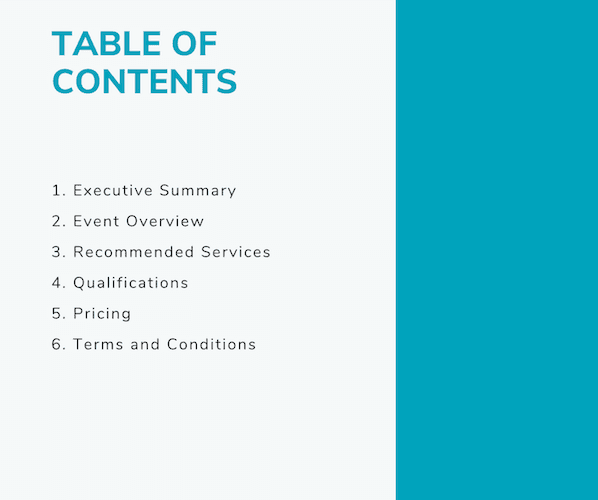
3. Explain your “why” with an executive summary.
The executive summary details exactly why you’re sending the proposal and why your solution is the best for the prospective client. Specificity is key here — why are you the best option for them.
Similar to a value proposition, your executive summary outlines the benefits of your company’s products or services, and how they can solve your potential client’s problem. After reading your executive summary, the prospect should have a clear idea of how you can help them — even if they don’t read the full proposal. Here’s what one should look like:
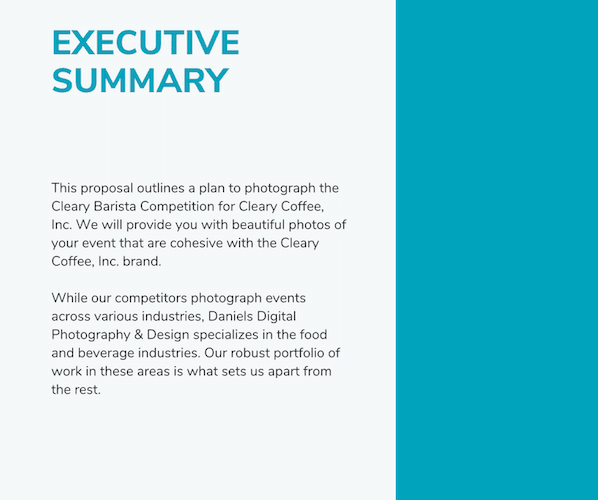
That example thoughtfully and effectively conveys both what the business does as a whole and how it can specifically serve the reader’s needs. Here’s what yours shouldn’t look like:
This particular example is extremely vague. It doesn’t allude to what the reader specifically stands to gain as a result of doing business with Outbound Telecom and fails to actually speak to why it should be considered “the best in its industry.”
4. State the problem or need.
This is where you provide a summary of the issue impacting the potential client. It provides you with the opportunity to show them you have a clear understanding of their needs and the problem they need help solving.
Research, critical thinking, and extra thought are key here. You have to do your homework. Take a holistic look at the specific issues your client is facing that you can help solve. Then, compellingly frame them in a way that sets you up for the next step.
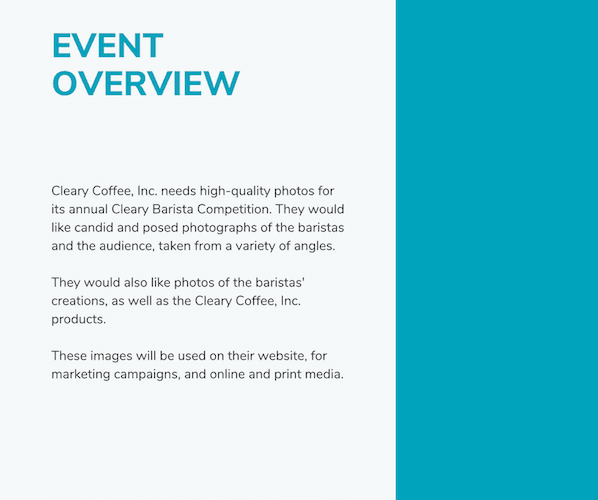
5. Propose a solution.
Here’s where you offer up a strategy for solving the problem. Like the last step, you need to lean into specificity and personalization in this one. Make sure your proposed solution is customized to the client’s needs so they know you’ve created this proposal specifically for them.
Let them know which deliverables you’ll provide, the methods you’ll use, and a timeframe for when they should expect them.

6. Share your qualifications.
Are you qualified to solve this prospect’s problem? Why should they trust you? Use this section to communicate why you’re best for the job. Include case studies of client success stories, mention any relevant awards or accreditations to boost your authority.

7. Include pricing options.
Pricing is where things can get a bit tricky, as you don’t want to under or over-price your product. If you’d like to provide the prospect a few pricing options for their budget, include an optional fee table. Some proposal software offer responsive pricing tables which allow clients to check the products or services they’re interested in, and the price will automatically adjust.
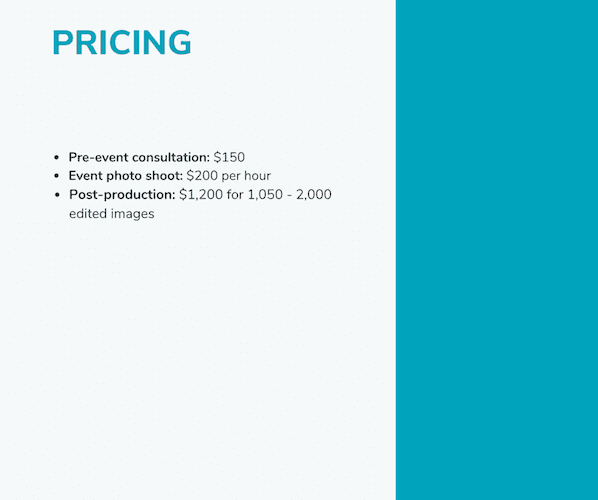
8. Clarify your terms and conditions.
This is where you go into detail about the project timeline, pricing, and payment schedules. It’s essentially a summary of what you and the client are agreeing to if they accept your proposal. Make sure you clear the terms and conditions with your own legal team before sending the proposal to the client.
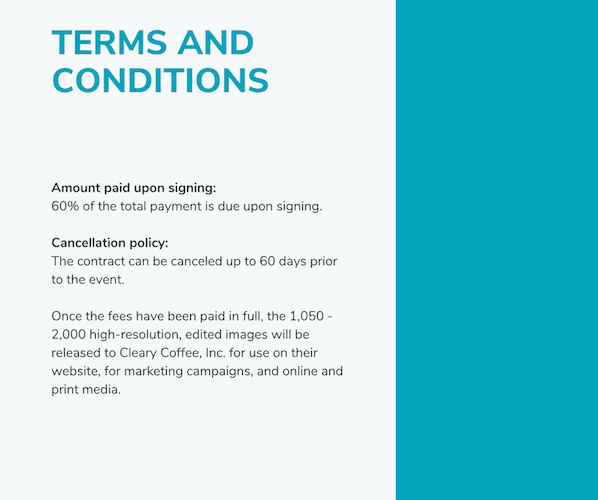
9. Include a space for signatures to document agreement.
Include a signature box for the client to sign and let them know exactly what they’re agreeing to when they sign. This is also a chance to include a prompt for the prospect to reach out to you if they have any unanswered questions you can address.

There’s a lot to keep in mind when writing a business proposal. Here are a few tips to help you out:
1. Start with an outline.
If you want to produce a thoughtful, effective business proposal, you need to have some idea of what you’re hoping to achieve with it. So before you dive into writing, outline the major sections of your business proposal and the pertinent information you want to include. This will ensure you stay focused and your message stays intact as you write.
2. Include data and visuals.
You want your business proposal to capture your prospect’s attention and help set you apart from any other ones they might have received. One of the best ways to do that is to include hard, quantitative data that helps stress the value of your business.
If you can find some relevant, compelling figures that highlight what you have to offer, you can establish authority and make yourself that much more convincing — it also helps to include visuals such as charts and graphs to enhance your proposal.
3. Add social proof.
Like the previous point, adding social proof lends your proposal another degree of credibility. You can only be so convincing when you’re personally talking up how awesome your business is.
Prospects are skeptical. In many — if not most — cases, they probably won’t take you at your word. They’ll likely trust peers and fellow customers than someone trying to win their business. That’s why including elements like customer quotes and testimonials can go a long way.
4. Incorporate video into your proposal.
If you’re doing an online proposal over a document or PDF, you can include multimedia elements to enhance the proposal experience. They can make your document richer and more engaging.
Whether you add video at the beginning as an intro to your proposal or in the project breakdown to verbally discuss some of the more confusing parts, extras like this can make an impression — especially on prospects who are visual or auditory communicators.
5. Use a call-to-action.
Prospects need direction. The best proposal in the world can only take you so far if you don’t clearly define next steps. That’s why you have to make sure the reader knows what to do next after reading your proposal.
A clear-cut call-to-action is the best way to get there. Define and highlight exactly what they should do to act on the interest your proposal has generated. Without that guidance, you might leave your reader in limbo.
6. Include up-sell and add-on opportunities.
They say you won’t receive unless you ask — readers won’t explore the upper tiers of your solutions if you don’t give them an opportunity to. If you want to use your business proposal as a chance to get the most out of a reader’s interest, you need to include some additional information about your business for them to act on. They need to know what else you have to offer.
7. Create a sense of urgency.
There’s no definitive blueprint for how long a business proposal has to be. Yours should be however long it takes to convey the information you want to get across.
That said, you’re best off focusing on quality over quantity. Keep your sentences short and simple, and avoid including too much business jargon. You want your proposal to be straightforward enough for anyone who picks it up to make sense of. So don’t get carried away with being too fancy.
8. Keep it simple.
There’s no definitive blueprint for how long a business proposal has to be. Yours should be however long it takes to convey the information you want to get across.
That said, you’re best off focusing on quality over quantity. Keep your sentences short and simple, and avoid including too much business jargon. You want your proposal to be straightforward enough for anyone who picks it up to make sense of. So don’t get carried away with being too fancy.
9. Make the decision for them.
Craft your copy in a way that seems like saying “no” to the proposal would be stepping over dollars to pick up pennies. Your offer should go above and beyond their expectations, and you should do everything in your power to eliminate frictions and objections along the way.
10. Stay on brand.
Don’t be afraid to let your company’s personality shine through in your proposal. Stay true to your brand and show the client what sets you apart from your competitors.
11. Quality control.
Your proposal needs to be clean and airtight. You don’t want to undermine your messaging by coming off as sloppy and unprofessional. Before you send the proposal out, make sure to read and reread it for any typos or grammatical errors.
Business Proposal Examples
In need of some inspiration before you begin writing? Here are example business proposal templates from popular business proposal software companies you can use to help create your proposal.
1. Web Design Proposal

Image Source: PandaDoc
This example demonstrates a clear understanding of the client’s needs. It includes a brief analysis of their current website and which specific features could be added or improved upon.
2. SEO Proposal

Image Source: Bidsketch
This proposal clearly outlines the steps that need to be taken to help the prospective client increase their visibility and traffic from search engines. They’ve created a table for each stage of the project timeline and included information on each deliverable and when it’s due.
3. Sales Proposal
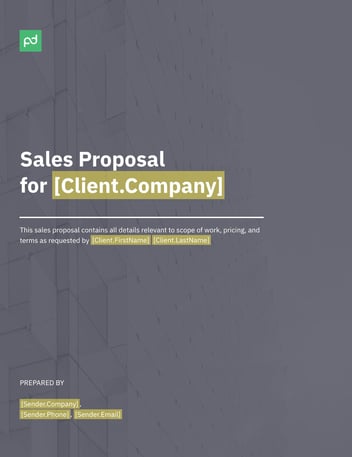
Image Source: PandaDoc
While this template is simple, it provides the prospect with an overview of the products and services you offer, and how they can be used to create a custom solution to address the client’s problem or goal.
4. Marketing Project Proposal
Some business agreements need a lot of information and detail to satisfy the audience. However, if your audience prefers a short and to-the-point summary of the project, this one-page proposal is right for you. Break down the issue, solution, strategy, goals, and costs on this attractive and easy-to-read template.
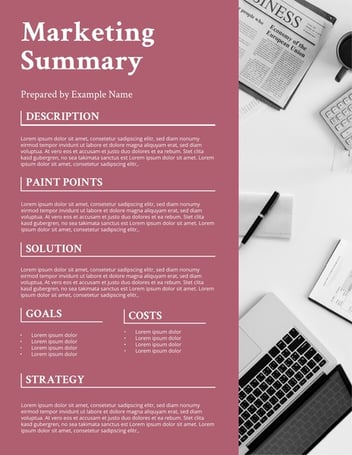
Image Source: Lucidpress
5. Business Consulting Proposal
This proposal goes a lot deeper with several different page layouts to meet your needs. You can pitch your offerings, break down the price, and show off your team with this sleek but bold consulting template.

Image Source: Proposify
6. Social Media Marketing Proposal
Image Source: PandaDoc
This template pairs engaging visuals with professional copy and solid structure. It’s an excellent option for any business looking for a proposal template that lends itself to thoughtful organization and effectively conveying any necessary information.
7. Content Marketing Proposal
Image Source: Nusil
This interactive template includes interesting copy that can serve as inspiration for any business looking to make a bold impression. If you’re looking for an engaging option for digital proposals, take a look at this template.
Depending on the type of business you’re in, your business proposal elements will vary based on the needs of the prospect. With a professional, customized business proposal you’re sure to delight your client and potentially gain their business.
Editor’s note: This post was originally published in February 2020 and has been updated for comprehensiveness.
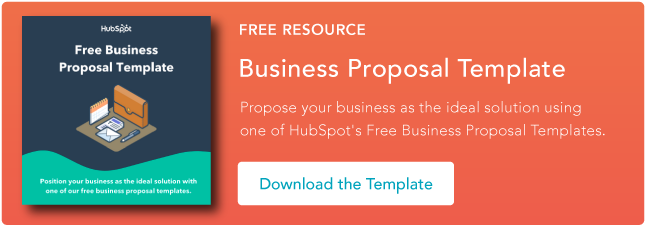
![]()

![You are currently viewing How to Write a Business Proposal [Examples + Template]](https://www.dimaservices.agency/wp-content/uploads/2021/04/0cac2396-7a14-436a-b5d7-7b12d6a3a1cf.png)

